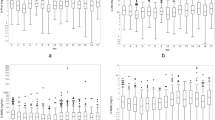Abstract
Objectives
To determine the population-based prevalence of albuminuria in Australian children and validate any negative correlation with body mass index (BMI).
Methods
Data from the Australian Health Survey 2011–2013 were used. This is a large-scale survey of the health of the Australian population, conducted by the Australian Bureau of Statistics, and uses a stratified, multistage area design with replicate weights attached to observations to allow for the derivation of accurate population estimates. We considered children aged 5–18 years, and defined albuminuria as an albumin-to-creatinine ratio (ACR) >30 mg/g (3.4 mg/mmol).
Results
A total of 975 children provided urine samples for determination of ACR. The prevalence of albuminuria was 10.2% for males (95% confidence interval [CI] 6.1–14.2) and 15.5% for females (95% CI 10.7–20.3). After adjusting for age and gender, the odds ratio for albuminuria associated with being overweight or obese was 0.34 (95% CI 0.15–0.75). This relationship also held for waist-to-height ratio, where the adjusted odds ratio for each 0.1 increase was 0.46 (95% CI 0.26–0.82).
Conclusions
Albuminuria, using a measurement suitable for population-based and clinical screening, occurs in 12.8% of school-aged Australian children, and is less common in overweight and obese children.


Similar content being viewed by others
References
Chronic Kidney Disease Prognosis Consortium (2010) Association of estimated glomerular filtration rate and albuminuria with all-cause and cardiovascular mortality in general population cohorts: a collaborative meta-analysis. Lancet 375:2073–2081
Iseki K, Kinjo K, Iseki C, Takishita S (2004) Relationship between predicted creatinine clearance and proteinuria and the risk of developing ESRD in Okinawa, Japan. Am J Kidney Dis 44:806–814
Johnson DW, Jones GRD, Mathew TH, Ludlow MJ, Chadban SJ, Usherwood T, Polkinghorne K, Colagiuri S, Jerums G, MacIsaac R, Martin H (2012) Chronic kidney disease and measurement of albuminuria or proteinuria: a position statement. Med J Aust 197:224–225
Gerstein HC, Mann JFE, Yi QT, Zinman B, Dinneen SF, Hoogwerf B, Halle JP, Young J (2001) Albuminuria and risk of cardiovascular events, death, and heart failure in diabetic and nondiabetic individuals. JAMA 286:421–426
Lea J, Greene T, Hebert L, Lipkowitz M, Massry S, Middleton J, Rostand SG, Miller E, Smith W, Bakris GL (2005) The relationship between magnitude of proteinuria reduction and risk of end-stage renal disease. Arch Intern Med 165:947–953
Ibsen H, Olsen MH, Wachtell K, Borch-Johnsen K, Lindholm LH, Mogensen CE, Dahlöf B, Devereux RB, De Faire U, Fyhrquist F, Julius S, Kjeldsen SE, Lederballe-Pedersen O, Nieminen MS, Omvik P, Oparil S, Wan Y (2005) Reduction in albuminuria translates to reduction in cardiovascular events in hypertensive patients: Losartan intervention for endpoint reduction in hypertension study. Hypertension 45:198–202
Atkins RC, Polkinghorne KR, Briganti EM, Shaw JE, Zimmet PZ, Chadban SJ (2004) Prevalence of albuminuria in Australia: the AusDiab kidney study. Kidney Int 66:S22–S24
Lurbe E, Torro MI, Alvarez J, Aguilar F, Fernandez-Formoso JA, Redon J (2013) Prevalence and factors related to urinary albumin excretion in obese youths. J Hypertens 31:2230–2236
Burgert TS, Dziura J, Yeckel C, Taksali SE, Weiss R, Tamborlane W, Caprio S (2006) Microalbuminuria in pediatric obesity: prevalence and relation to other cardiovascular risk factors. Int J Obes 30:273–280
Csernus K, Lanyi E, Erhardt E, Molnar D (2005) Effect of childhood obesity and obesity-related cardiovascular risk factors on glomerular and tubular protein excretion. Eur J Pediatr 164:44–49
Nguyen S, McCulloch C, Brakeman P, Portale A, Hsu C (2008) Being overweight modifies the association between cardiovascular risk factors and microalbuminuria in adolescents. Pediatrics 121:37–45
Australian Bureau of Statistics (2013) Australian health survey: users’ guide, 2011–13. ABS, Canberra
Rademacher ER, Sinaiko AR (2009) Albuminuria in children. Curr Opin Nephrol Hypertens 18:246–251
Cole TJ, Bellizzi MC, Flegal KM, Dietz WH (2000) Establishing a standard definition for child overweight and obesity worldwide: international survey. BMJ 320:1–6
Daniels SR, Greer FR (2008) Lipid screening and cardiovascular health in childhood. Pediatrics 122:198–208
Donath SM (2005) How to calculate standard errors for population estimates based on Australian National Health Survey data. Aust N Z J Public Health 29:565–571
Hirschler V, Molinari C, Maccallini G, Aranda C (2010) Is albuminuria associated with obesity in school children? Pediatr Diabetes 11:322–330
Park SJ, Lim JW, Cho BS, Yoon TY, Oh JH (2002) Nutcracker syndrome in children with orthostatic proteinuria: diagnosis on the basis of Doppler sonography. J Ultrasound Med 21:39–45
Ragazzi M, Milani G, Edefonti A, Burdick L, Bianchetti MG, Fossali EF (2008) Left renal vein entrapment: a frequent feature in children with postural proteinuria. Pediatr Nephrol 23:1837–1839
Singh A, Satchell SC (2011) Microalbuminuria: causes and implications. Pediatr Nephrol 26:1957–1965
Matsell DG, Cojocaru D, Matsell EW, Eddy A (2015) The impact of small kidneys. Pediatr Nephrol 30:1501–1509
Brandt JR, Jacobs A, Raissy HH, Kelly FM, Staples AO, Kaufman E (2010) Orthostatic proteinuria and the spectrum of diurnal variability of urinary protein excretion in healthy children. Pediatr Nephrol 25:1131–1137
Garg AX, Suri RS, Barrowman N, Rehman F, Matsell D, Rosas-Arellano MP, Salvadori M, Haynes RB, Clark WF (2003) Long-term renal prognosis of diarrhea-associated hemolytic uremic syndrome: a systematic review, meta-analysis, and meta-regression. JAMA 290:1360–1370
Askenazi DJ, Feig DI, Graham NM, Hui-Stickle S, Goldstein SL (2006) 3–5 year longitudinal follow-up of pediatric patients after acute renal failure. Kidney Int 69:184–189
Author information
Authors and Affiliations
Corresponding author
Ethics declarations
Ethics approval was obtained from the Australian Government Department of Health and Ageing Departmental Ethics Committee.
Conflict of interest
The authors declare that they have no conflict of interest.
Funding source
Supported by the National Health and Medical Research Council (APP1092957 program grant including ATP; GNT1114218 to NL).
Rights and permissions
About this article
Cite this article
Larkins, N., Teixeira-Pinto, A. & Craig, J. The population-based prevalence of albuminuria in children. Pediatr Nephrol 32, 2303–2309 (2017). https://doi.org/10.1007/s00467-017-3764-7
Received:
Revised:
Accepted:
Published:
Issue Date:
DOI: https://doi.org/10.1007/s00467-017-3764-7




